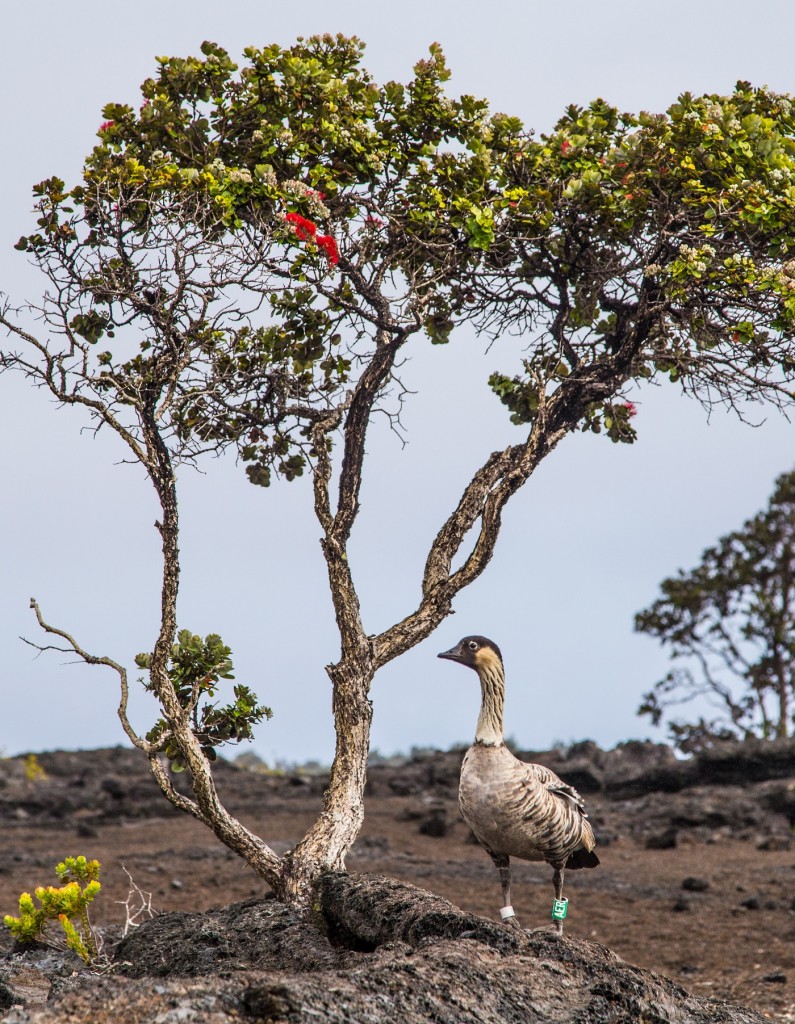Rapid ʻŌhiʻa Death Spreads to Hamakua
From the road, in the Laupahoehoe Section of the Hilo Forest Reserve, Steve Bergfeld of the Hawai’i Department of Land and Natural Resources spotted the enormous, towering, ōhiʻa tree; its thick branches now completely without leaves.
The Hawai’i Island branch manager for the DLNR Division of Forestry and Wildlife wanted to get a close-up look at the tree after a technician first spotted it and took samples a week ago.
Two laboratory tests have confirmed that this very old tree was killed by the fast-moving fungal infection known as Rapid ʻŌhiʻa Death.
Across Hawai’i Island, the disease is killing trees and devastating tens of thousands of acres of native forest.
First reported in the Puna District in 2010, the latest aerial surveys show that the fungus has impacted nearly 50,000 acres of forest here.
Named for the rapidity in which it kills infected trees, the loss of the 100- to130-foot-tall ōhiʻa in the Laupahoehoe forest, and perhaps others around it, shows the disease has spread to the island’s eastern side along the Hamakua Coast.
“It’s devastating to look at the forest and the damage Rapid ʻŌhiʻa Death is doing to our ecosystem and our watersheds,” Bergfeld observed. “That tree is a giant in the forest. It also supports a lot of other plant life and bird life. It was an important part of our ecosystem. These trees have been here for hundreds of years and to see them go down to a disease like this is really heartbreaking.”
ʻŌhiʻa trees are culturally significant and their flowers are prized for lei making.
Foresters consider ōhiʻa the most important species for protecting the state’s forested watersheds for its dense canopy, where virtually all domestic water supplies originate. That’s why a strong collaboration between state and federal government agencies and conservation organizations is actively researching the cause of the disease, potential treatments, and the establishment of quarantines and protocols to prevent further spread.
The identification of this diseased tree is the latest example of this cooperative effort. The tree was spotted by a technician from the U.S. Forest Service’s Institute of Pacific Island Forestry, who collected the wood samples for lab testing.
Verification of Rapid ʻŌhiʻa Death, as the trees cause of death, was done by the U.S. Dept. of Agriculture’s Pacific Basin Agricultural Research Center in Hilo. An entomologist from the University of Hawai‘i’s College of Tropical Agriculture and Human Resources Extension Service also collected samples for research that suggests beetles are a primary cause for the spread of the fungus.
Bergfeld explains the next steps involving experts from the Rapid ʻŌhiʻa Death working group.
“We’ll put everyone’s heads together and see what the best management strategy will be for this particular tree,” said Bergfeld. “I assume, more than likely, we’ll fell the tree to get it out of the forest and cover it with tarps to keep insects from putting out frass (the powdery refuse or fragile perforated wood produced by the activity of boring insects), into the air.”
Experts are very concerned that with the confirmation of Rapid ʻŌhiʻa Death in this tree, the disease has spread to a previously unaffected area farther up the Hamakua Coast: a forest already impacted by a 2013-14 outbreak of the Koa looper, a native insect that defoliates entire koa trees during rare, unexplained outbreaks.
Gov. David Ige, lead scientists and policy makers engaged in the fight against Rapid ʻŌhiʻa Death will gather for the first-ever summit on the disease at the State Capitol on Wednesday, Nov. 30, 2016.
The event is open to the public and is scheduled from 9 a.m. to 3 p.m. in the Capitol Auditorium.
















